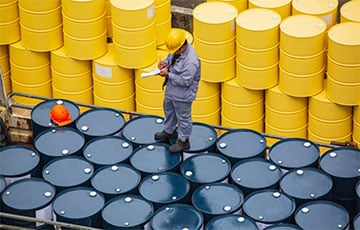Iran Has Begun Rapidly Removing Oil From Its Storage Facilities
- 2,264

Oil pours from Iranian ports into ocean-going tankers.
The attention of oil market participants amid the military confrontation between Israel and Iran is largely focused on whether the stability of crude export supplies can be maintained. So far, Iranian oil fields are working smoothly, and loading from storage facilities to tankers has even begun to grow rapidly. Iran is seeking to disperse its stockpiles on the one hand, and on the other, to have time to sell more oil amid greatly increased risks.
"Oil is flowing from [Iranian] ports to ocean-going tankers, which guarantees revenues - at least for some time - even in the event of supply disruptions. Despite the surge [in shipments], the tanks at the country's most important export terminal on Kharq Island are full of crude," Bloomberg described the situation after analyzing satellite imagery.
On June 11, almost all tanks were only partially full, but on June 18, the sixth day of the Israeli strikes, all were full to the brim. Normally, with increased exports, the tanks would be empty, but now Iran is apparently pumping oil into them to the max to get as much out on tankers as possible, says Samir Madani, co-founder of TankerTrackers.com, which specializes in tracking oil trade using shadow fleets.
According to TankerTrackers.com, Iran exported an average of 2.33 million barrels per day in the five days since June 13, when the attacks began; that's 44 percent more than the year-to-date average of 1.61 million barrels through June 14. "It seems crystal clear what they are doing," Madani says. - They are trying to export as many barrels as possible, with security being their number one priority."
Taking out more volumes will not only generate more money in the short term, especially given the price spike (Brent has risen from around $70 to $77 since the start of hostilities, and has climbed as high as $79 a barrel during trading). Tehran also hopes to reduce the likelihood of losses in the event of Israeli strikes on the terminal. Until June 13, tankers usually waited to load at a roadstead near the island, but now they are scattered far away from it and approach only to receive oil and leave the terminal as quickly as possible, satellite images show.
One of the main fears for market participants is the possibility of Iran closing the Strait of Hormuz, a narrow exit from the Persian Gulf through which other countries in the region also export oil. So far, there are no obstacles on this path. All of Iran's oil exports go by sea, and virtually its only buyer is China, JP Morgan pointed out this week. According to its analysts, closing the strait would be counterproductive for Iran's relations with China, which buys more than 90% of its crude, which due to sanctions is mostly delivered by shadow fleet and sold at a discount.
In normal mode, Iran exports 1.6-1.7 million barrels per day. And OPEC countries have spare capacity of 5 million bpd, and in case of supply disruptions they can quickly increase supplies to the global market, ING analysts wrote in the report. This is also the reason why they expect prices not to go higher and stabilize in the range of $75-80 per barrel.
In afternoon trading on Friday, Brent cost about $77 per barrel.











